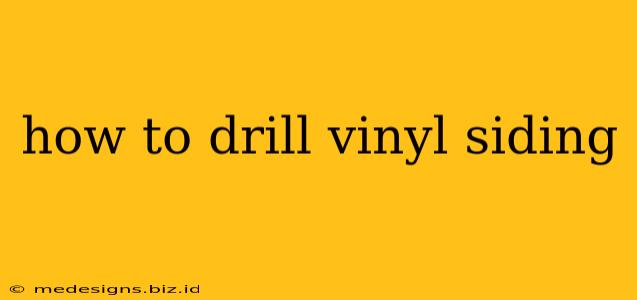Drilling into vinyl siding can seem daunting, but with the right technique and tools, it's a manageable task for any homeowner. Improper drilling can easily lead to cracks and damage, so understanding the process is crucial. This comprehensive guide will walk you through how to drill vinyl siding safely and effectively, minimizing the risk of damage.
Understanding Vinyl Siding
Before we dive into the drilling process, it's important to understand the material itself. Vinyl siding is a relatively soft plastic, making it susceptible to cracking under pressure. The key to successful drilling is to minimize the amount of heat and pressure generated during the process.
Tools You'll Need
Gathering the right tools beforehand is essential for a smooth and efficient job. You'll need:
- Sharp Drill Bit: A sharp drill bit is paramount. A dull bit will require more pressure, increasing the chance of cracking. Use a bit specifically designed for vinyl or plastic. Avoid using a standard wood or metal bit.
- Drill: A variable-speed drill allows for better control, letting you adjust the speed to a lower setting.
- Drill Bit Size: Choose a drill bit slightly smaller than the fastener you'll be using. This allows for a snug fit without excessive pressure.
- Safety Glasses: Always protect your eyes from flying debris.
- Painter's Tape (Optional): Applying painter's tape to the area you'll be drilling can help prevent chipping and cracking.
- Backer Board (Recommended): For added support, especially when drilling larger holes, using a backer board behind the siding prevents splitting.
Step-by-Step Drilling Guide
1. Prepare the Area
Identify the exact location where you need to drill. Clean the area with a damp cloth to remove any dirt or debris that could interfere with the drilling process. If using painter's tape, apply it firmly to the area you'll be drilling. This provides extra support and helps prevent chipping.
2. Choose the Right Drill Bit
Select a drill bit that is slightly smaller than the diameter of the fastener you'll be using. Using too large of a bit weakens the siding and increases the chance of cracking. Always use a sharp drill bit designed for plastic or vinyl.
3. Slow and Steady Wins the Race
Set your drill to a low speed. This minimizes the heat generated during drilling, reducing the risk of melting or cracking the vinyl. Apply firm, even pressure throughout the drilling process. Avoid applying excessive pressure.
4. Use a Backer Board
For added protection, especially when installing larger items, place a backer board behind the siding before you drill. This provides crucial support and prevents the vinyl from cracking or splitting.
5. Drill the Hole
Begin drilling slowly and steadily, keeping the drill bit perpendicular to the surface. Let the drill bit do the work; avoid applying excessive force. If you feel resistance, stop and check your setup. A dull bit or excessive pressure is often the culprit.
6. Finishing Touches
Once the hole is drilled, remove any debris from the hole. You can then proceed with installing your fastener.
Troubleshooting Common Problems
- Cracking: This usually happens due to using a dull bit, excessive pressure, or drilling too quickly. Use a sharp bit, reduce the speed and pressure, and consider using a backer board.
- Chipping: This can be minimized by using painter's tape and drilling slowly and steadily.
- Melting: This indicates you are drilling too fast. Reduce the speed and ensure your drill bit is sharp.
Tips for Success
- Practice on Scrap: Before drilling into your actual siding, practice on a scrap piece of vinyl to get a feel for the process and to ensure your technique is correct.
- Lubrication: A drop of lubricant (like silicone spray) can sometimes help reduce friction and heat build-up.
- Multiple Holes: When drilling multiple holes, allow time for the vinyl to cool between holes. This helps prevent melting and cracking.
By following these steps and tips, you can confidently drill into your vinyl siding without causing damage. Remember safety first and always prioritize a slow and steady approach. Happy drilling!
